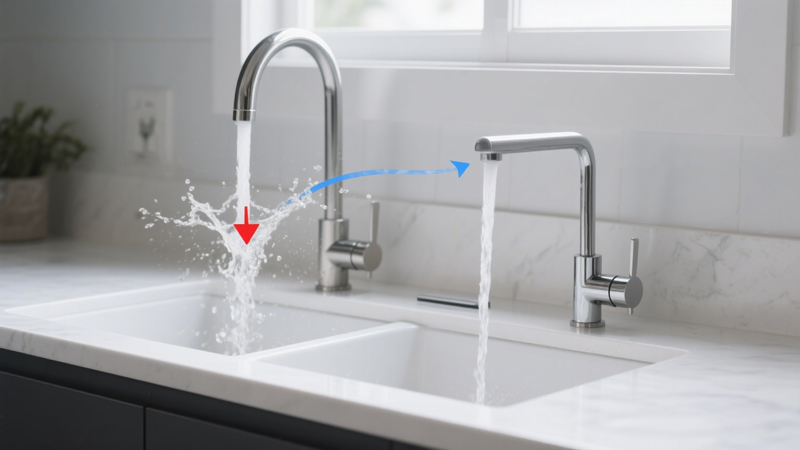
Deep sinks are incredibly popular in modern kitchens for their utility and sleek aesthetics. They make it easier to wash large pots and pans, reduce visible mess, and help contain water within the basin. However, one downside that many homeowners encounter is excessive splashing, especially when paired with high-pressure or poorly positioned faucets.
If you’ve recently upgraded to a deep sink—or are planning to—you may be wondering: Why does water splash so much? And more importantly, how can I prevent it? This post will walk you through the causes of splashing and offer practical solutions to minimize it without compromising on design or functionality.
Why Splashing Happens in Deep Sinks
To fix a problem, it’s helpful to understand the cause. Splashing occurs when water from the faucet hits the sink basin, dishes, or your hands at high speed or the wrong angle. Here’s why deep sinks can be especially prone:
-
Increased vertical distance between the faucet and the bottom of the sink means more water velocity when it hits the surface.
-
Faucet height might be too high, intensifying the water’s impact.
-
Sink shape and slope can affect how water rebounds.
-
High water pressure contributes to turbulent flow.
-
Improper faucet aerators can disrupt the water stream and cause droplets to scatter.
1. Choose the Right Faucet Height
The number one rule for deep sinks: don’t go too high with your faucet.
A high-arc faucet might look elegant, but when combined with a deep basin, it creates a significant drop distance for the water—leading to a stronger splash.
✔️ Best Practice:
-
Look for medium-height or low-profile faucets for deep sinks.
-
If you love the look of a tall gooseneck faucet, choose one with adjustable flow settings or built-in splash control features.
2. Use an Aerator to Soften the Flow
Most modern faucets come with aerators, which mix air into the water stream to create a softer, more controlled flow. If your faucet doesn’t have one—or if yours is clogged or poorly designed—it could be the reason for splashing.
✔️ What to Do:
-
Install a high-quality faucet aerator with a laminar or aerated stream.
-
Choose one with a swivel option so you can direct the stream more precisely.
This small addition can make a big difference in reducing turbulence and keeping water flow clean and gentle.
3. Adjust Water Pressure
If your faucet is blasting water like a firehose, it’s time to turn down the pressure.
Too much pressure causes water to hit the sink with force, bouncing off and splashing everywhere—especially in a deep bowl where water has more time to pick up speed on its way down.
✔️ How to Adjust:
-
Use the shutoff valves under your sink to slightly reduce the flow rate.
-
You can also opt for a flow restrictor attachment or faucet with variable pressure settings.
Less pressure = less splash.
4. Mind the Angle of the Faucet Spout
The direction of the water stream matters more than most people realize. Faucets with a straight-down vertical stream often hit the sink base directly, causing splash-back. A slight forward angle can help water move toward the drain rather than bouncing off flat surfaces.
✔️ Ideal Positioning:
-
Choose a faucet where the water lands directly over the drain.
-
Avoid faucets where water lands too close to the front or side of the sink.
If your current setup causes water to hit the edge of a pan or the corner of the sink, expect a mess.
5. Use a Sink Grid or Mat
Sink grids or rubber mats aren’t just for protecting dishes—they’re great splash reducers, too. They break the force of the water as it falls, acting as a barrier between the stream and the hard base of the sink.
✔️ Benefits:
-
Prevent water from splashing on impact.
-
Protect the sink from scratches.
-
Allow water to drain underneath without pooling.
They’re inexpensive and easy to clean—win-win.
6. Use Proper Sink Bowl Design
Some sinks are more prone to splashing than others. Features like steep slopes or flat bases can change how water behaves.
✔️ Ideal Features:
-
Gently curved sink walls help direct water smoothly.
-
A sloped base that funnels water toward the drain reduces pooling and splash.
-
Deep sinks should ideally have a satin or brushed finish, which diffuses water impact better than glossy surfaces.
If you’re still in the planning stages, ask your installer or designer about these features.
7. Upgrade to a Pull-Down or Pull-Out Faucet
Pull-down and pull-out faucets let you control where and how water flows, reducing the risk of splash.
Instead of water falling from a fixed height, you can bring the spout closer to the item you’re rinsing or direct the spray exactly where you need it.
✔️ What to Look For:
-
Ergonomic handle for smooth control.
-
Switchable spray settings (stream vs. shower mode).
-
Retractable hose with smooth retraction.
These faucets offer both precision and convenience, perfect for splash control in deep sinks.
8. Develop Better Water Habits
Even the best setup won’t help if your water habits cause splashing. Avoid turning the faucet on full-blast, especially when rinsing light dishes or running water into an empty sink.
✔️ Small Changes:
-
Turn on water gradually, not instantly to full power.
-
Don’t place dishes directly under the stream—angle them.
-
Avoid rinsing into a dry sink; pre-wet it or rinse toward the drain.
Conclusion
Splashing is a common frustration for deep sink owners, but it’s far from inevitable. With the right faucet selection, sink accessories, and water usage techniques, you can drastically reduce splash—and enjoy the benefits of your deep sink without the mess.
Whether you’re remodeling your kitchen, upgrading a faucet, or just troubleshooting an annoying splash problem, these tips can help you get cleaner results with less cleanup.
 iVIGA Faucet Online Shop
iVIGA Faucet Online Shop

